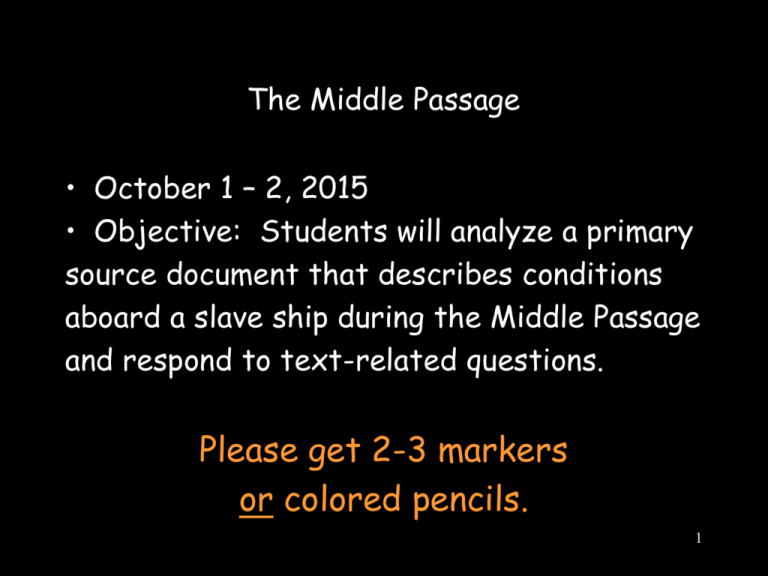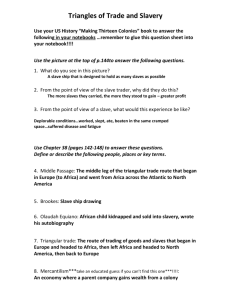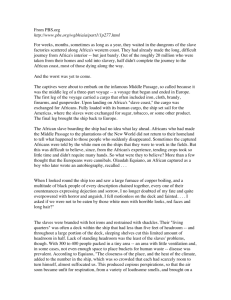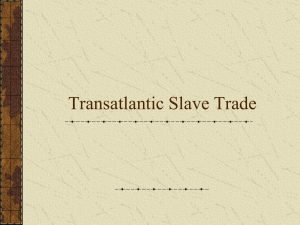themiddlepassage (1)
advertisement

The Middle Passage • October 1 – 2, 2015 • Objective: Students will analyze a primary source document that describes conditions aboard a slave ship during the Middle Passage and respond to text-related questions. Please get 2-3 markers or colored pencils. 1 Warm-Up: How does geography influence colonization? Include the terms ‘subsistence agriculture’ and ‘commercial agriculture’ in your explanation. You may work with your seatmate. For help, see AAA p. 181 or SA&E p. 109. For weeks, months, sometimes as long as a year, they waited in the dungeons of the slave factories scattered along Africa's west coast. They had already made the long, difficult journey from Africa's interior …….. but just barely. 4 Of the 20 million Africans who were taken from their homes and sold into slavery, nearly half did not complete the journey to the African coast, many of them dying along the way. And the worst was yet to come… 5 Triangular Trade 6 first leg of the Triangular Trade Manufactured goods leave Europe for Africa: cloth, spirits, tobacco, beads, metal goods, and guns. These goods were exchanged for African citizens who would work as slaves in the New World. 7 second leg of the Triangular Trade The Middle Passage was the journey over the Atlantic Ocean with 400-500 people in a boat with little air and much disease. The trip could take from 2 - 4 months, depending on trade winds. Why did Europeans ship millions of Africans to the New World? 8 (By the way,….) Africans were skilled laborers. They often had experience in farming and livestock raising. Africans were also ….. • accustomed to the tropical climate • resistant to tropical diseases 9 third leg Raw materials planted and harvested from slave-labor in the colonies were shipped to Europe. 10 • • https://www.youtube.com/watch?v=pYfCRRNxX2o https://www.youtube.com/watch?v=alMd9bvMTRY 1. Duplicate the Triangular Trade between Europe, Africa and the Americas in your notebook. (reference today’s notes) 2. Use arrows and words to identify each leg of the Triangle. 3. Label the Middle Passage. 11 12 Look for the key ideas in the following photos of the Middle Passage. Ask yourself: What details are helping me understand the topic? 13 Captured! Tribes often helped capture tribal enemies, a “divide and conquer” strategy encouraged by the Europeans. Many were captured as far as 50-100 miles inland. 14 Slave forts Christiansborg Castle, Gold Coast, ca. 1750 Cape Coast Castle, Gold Coast, 1727 15 Slaves being rowed to a newly arrived slaving ship off the Guinea coast – note the trading fort in the background. Crosssection of a slave embarkat ion canoe. 16 Boarding the ship Boarding the ship andand being and then beingchained chained and being sent down the then being senttodown slave decks. to the slave decks. 17 The model and charts were used by slave reformers at the end of the 18th century to show how a slave ship could carry 400 slaves. On one voyage the ship carried 609 slaves. 18 A successful voyage could expect a loss rate of 1 in 20 slaves. A bad run might suffer losses as high as 1 in 3, mainly due to disease. The space between the deck shelves could vary from 28 to 39 inches. 19 Africans were crowded and cruelly chained aboard 20 slave ships. Slaves were fed twice a day. Male slaves were chained, women and children usually 21 went unshackled. Slaves were brought up on to the top deck to be ‘exercised’ or ‘danced’ usually once a day. This was usually at the point of a whip. This was the most dangerous time for the ship’s crew when the slaves had an opportunity to rebel. A loaded cannon was always kept ready with a lighted match. 22 Diseased and rebellious slaves were often thrown overboard. 23 24 Brain break • • http://www.nbcnews.com/nightly-news/why-barber-giving-free-haircuts-kidswho-read-him-n420581 http://www.nbcnews.com/nightly-news/video/retired-u.s.-marine-appeals-forhelp-for-afghan-interpreter-527651395867 “Eyewitness to History: Aboard a Slave Ship, 1829”. • slaver – slave ship • interceptor – patrols looking to stop (intercept) the slave ships. • http://www.eyewitnesstohistory.com/pfslaveship.htm 26 Answer in your notebook. No pronouns. 1. Describe three things the author said that you think are important. (At least 3 sentences.) 2. Explain why you think this document was written and to whom it may have been written. Provide a quote from the document to support your answer. (At least 3 sentences.) 3. What question do you have that is left unanswered in the document? 27 Answer on the paper I give you. Use RACE (5-7) from your notes and today’s lesson. Turn in for a class assignment grade. Who benefited from the establishment of colonies in the Americas? What kinds of hardships did the establishment of the colonies create for Africans and for Native Americans? 28





